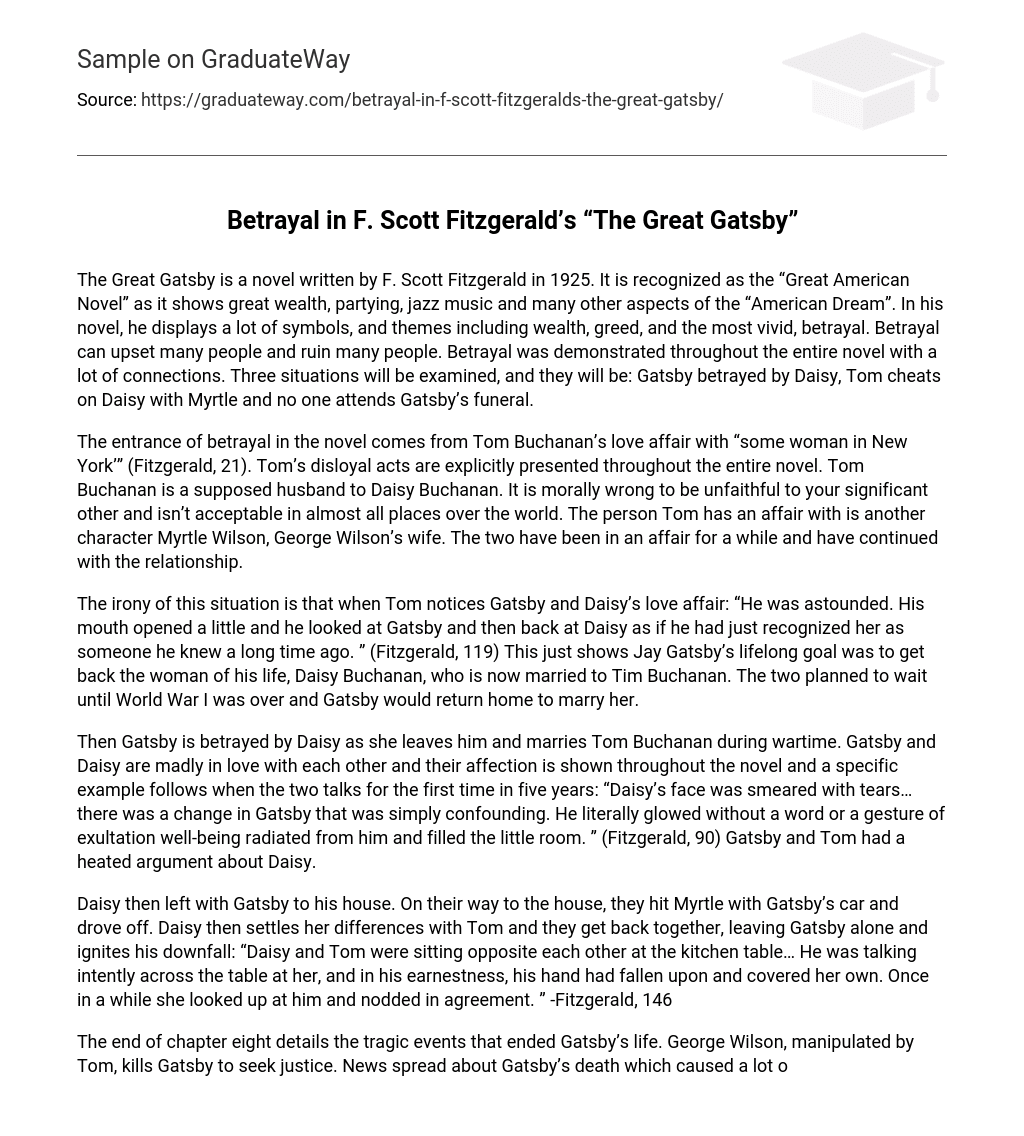The novel The Great Gatsby, written by F. Scott Fitzgerald in 1925, is often hailed as the quintessential expression of the “Great American Novel.” It depicts the grandeur of great wealth, extravagant parties, the enchanting allure of jazz music, and various aspects associated with the “American Dream.” Fitzgerald skillfully incorporates symbols and themes throughout his work, highlighting notions such as wealth, greed, and perhaps most poignantly, betrayal. Betrayal, a deeply unsettling act that can shatter lives and relationships, permeates this novel extensively, intertwining characters and events. Three instances exemplify this recurrent theme of betrayal: Gatsby’s betrayal by Daisy, Tom’s infidelity with Myrtle, and the absence of mourners at Gatsby’s funeral.
Tom Buchanan’s extramarital affair in the novel stems from his romantic entanglement with “some woman in New York” (Fitzgerald, 21). Throughout the novel, Tom consistently exhibits acts of betrayal. Despite being married to Daisy Buchanan, it is universally recognized that infidelity is morally and socially reprehensible. Tom’s affair is specifically with Myrtle Wilson, who happens to be George Wilson’s wife. Their illicit relationship has endured for a significant duration.
Tom is astonished when he sees Gatsby and Daisy together romantically, which is ironic. Fitzgerald describes Tom’s surprise by noting his slightly open mouth and his gaze shifting between Gatsby and Daisy, as if he had suddenly recognized her from a distant past (119). This emphasizes Gatsby’s ultimate ambition – to be reunited with his long-lost love, Daisy Buchanan. However, Daisy is now married to Tim Buchanan. Gatsby’s plan was to wait for the end of World War I so that he could return and marry her.
After being betrayed by Daisy, Gatsby is heartbroken when she chooses to marry Tom Buchanan during wartime. However, the novel portrays their intense love for each other, as demonstrated when they have their first conversation in five years. The narrator describes Daisy’s tear-streaked face and the noticeable transformation in Gatsby, who radiates with a glowing aura and a sense of satisfaction. Despite their deep affection, Gatsby and Tom engage in a fiery argument over Daisy.
Daisy and Gatsby went to his house, but on the way, they struck Myrtle with Gatsby’s car before continuing. Later, Daisy reconciled with Tom, and they reunited, leaving Gatsby alone and causing his downfall. According to Fitzgerald (146), Daisy and Tom sat facing each other at the kitchen table. Tom was speaking passionately to her, and his hand had gently landed on top of hers. Occasionally, she would glance up at him and nod in agreement.
In chapter eight, Gatsby’s life comes to a tragic end as detailed in the text. Tom manipulates George Wilson, leading to Gatsby’s murder in pursuit of justice. The news of Gatsby’s death quickly spreads, attracting a multitude of people to his house. These visitors include journalists, photographers, police officers, and various media personnel who are not personally acquainted with him. Everyone, except Nick, believes that Gatsby is responsible for Myrtle’s death and that Wilson is emotionally unstable due to grief (Fitzgerald, 164). The investigation reaches its conclusion, and subsequently, the funeral takes place.
Gatsby requested Nick to contact all the usual party attendees as he couldn’t handle it alone: “You must find someone for me. You have to make an effort. I cannot confront this by myself.” (Fitzgerald, 166) Nevertheless, none of the partygoers complied and only provided excuses. The Buchanans, Tom and Daisy, had relocated without providing a new address, while Meyer Wolfsheim alleged being occupied with crucial matters to participate at that time. Gatsby’s alleged “friends” failed to organize any gatherings to show their support for him.
Only a few individuals attended the service: Nick, Gatsby’s father, Owl Eyes, and a handful of Gatsby’s servants. It was not only Gatsby who felt betrayed, but Nick as well. The Great Gatsby effectively depicted betrayal at a deeply personal level. Fitzgerald skillfully conveyed this theme through his characters, particularly Tom Buchanan, who I perceive as the most deceitful individual in the story. The novel successfully portrayed betrayal as a profoundly overwhelming emotion.
Bibliography
- Fitzgerald, F. Scott. The Great Gatsby. New York: Macmillan Publishing Company, 1986. Print.





